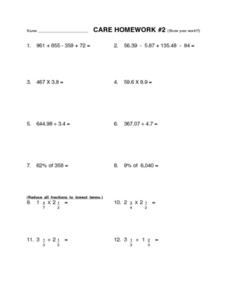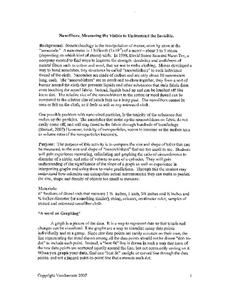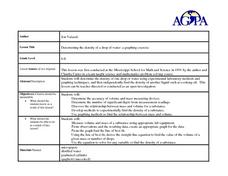Curated OER
Thirsty Rocks: Please "Porous" a Drink!
A simple activity goes a long way in demonstrating the property of porosity to your rock hounds. They will mass a specimen of dry sandstone and then soak it in a pre-measured amount of water. After seven minutes, they once again measure...
Virginia Department of Education
The Law of Conservation of Matter
The Law of Conservation of Matter can be complex for young scientists to fully grasp. Use this experiment to help simplify the process as pupils perform two experiments to determine mass: one that melts a substance and the other that...
Curated OER
Determining Liquid Densities
Young scholars practice determining liquid densities in a short, hands-on lab activity. Students use a graduated cylinder to measure out 100 milliliters of a liquid, find its mass using a balance, and record measurements in a data...
Curated OER
Making Sense of Density
Students identify the concepts of density, mass, and volume that define the property of a substance. They also determine that the properties of materials, such as, density and volume, can be compared and measured by using rulers,...
Curated OER
DENSITIES OF REGULARLY SHAPED SOLIDS
Students calculate the volumes of regularly shaped objects from measurements of their dimensions. They use several formulas and measure different objects to calculate the density, volume, and mass of the objects selected or assigned.
Curated OER
To Float or Not to Float - A Lesson on Density
Students define density in their own words. In this physics lesson, students calculate density using mass and volume. They explain why some objects sink and some float.
Curated OER
Care Homework #2
In this Care Homework worksheet, students solve a variety of multiple digit addition, subtraction, multiplication, and division problems that include fractions, decimals, and percentages. They demonstrate knowledge of geometric formulas...
Alabama Learning Exchange
It's Around There Somewhere! Perimeter, and Circumference
Explore the concept of building equations for perimeter and circumference. Learners use rulers to measure the perimeter of half a sheet of paper. Then fold the sheet of paper numerous times, each time measuring perimeter. ...
Curated OER
Convert This!
Learners use conversion factors to solve problems. In this algebra lesson, students convert between Metric and English Units. They measure different objects and using both systems in their units.
Curated OER
Egg Measurement
Pupils explore measurement and units. They measure eggs to determine their density, mass and percent composition. An inquiry approach is used for students to ascertain the mass.
Curated OER
Liquids of Different Densities
Students compare the densities of different liquids. In this liquids lesson plan, students compare color, viscosity, weight, volume, and graph their findings.
Curated OER
Nanofibers: Measuring the Visible to Understand the Invisible
Students compare the size and shape of tubes that can be measured, to the size and shape of "nanowhiskers" that are too small to see. They practice measuring, calculating and graphing the ratio of circumference to diameter of a circle,...
Cornell University
Buoyancy
Swimmers know to float by turning their bodies horizontally rather than vertically, but why does that make a difference? In an interesting lesson, scholars explore buoyancy and the properties of air and water. They test cups to see which...
Curated OER
The Metric System
Learners practice converting metric measurements by completing the activities listed in this instructional activity. They first practice measuring common objects. They then convert metric measurements using the included worksheet.
Curated OER
A Cone and Its Net
Create and investigate nets for solid shapes with your class. They identify the different parts and faces of each polygon and solid then calculate the surface area and volume of cones. They use circle sectors of varying sizes to build...
Curated OER
Determining the Density of a Drop of Water-A Graphing Exercise
Students determine the density of 1 drop of water. For this determining density lesson plan, students determine the mass and volume of a drop of water in the lab using appropriate lab techniques and calculate the density of a drop of water.
Curated OER
Water Conservation
Students explore types of water reserves. In this water conservation lesson plan, students brainstorm ways water are used in their homes. Students use a graduated cylinder to simulate the amount of water on Earth and the amount that...
Curated OER
Matter
Young scholars complete a unit of activities to learn about states of matter and how to measure matter. In this matter lesson, students complete 8 lessons to learn about matter, its states, and how to measure matter.
Curated OER
How Can we Measure the Rate of a Chemical Reaction?
Pupils examine different types of chemical reactions. They explore how alcohol molecules affect the reaction rates. They answer discussion questions to end the lesson.
Cornell University
Density
Certain things just do not mix, including liquids of varying densities. Learners collect data to determine the densities of several liquids. They then use the density information to predict the type of liquid.
EduGAINs
Making Savvy Consumer Choices
It's never too early to learn about grocery budgeting. Middle schoolers delve into the world of consumer math with a lesson that focuses on both healthy choices and real-world math applications. Groups work together to form a grocery...
Curated OER
Tennis Balls in a Can
Make your classroom interesting by teaching or assessing through tasks. Deepen the understanding of Geometry and motivate young mathematicians. The task uses investigation with tennis balls and their container to prompt learners to...
Curated OER
Water Treatment Plant Tour
Students define vocabulary related to geometry and calculate the volume. In this geometry lesson, students calculate flow rates, and volume as it relates to a water plant facility. They calculate the volume of three dimensional shapes...
Curated OER
Chemistry Lab-Heat of Fusion
Students determine the heat of fusion of ice. In this heat of fusion lesson plan, students use a calorimeter to measure the molar heat of fusion of ice. Students determine the heat required to melt one mole of ice using hot water and ice...























